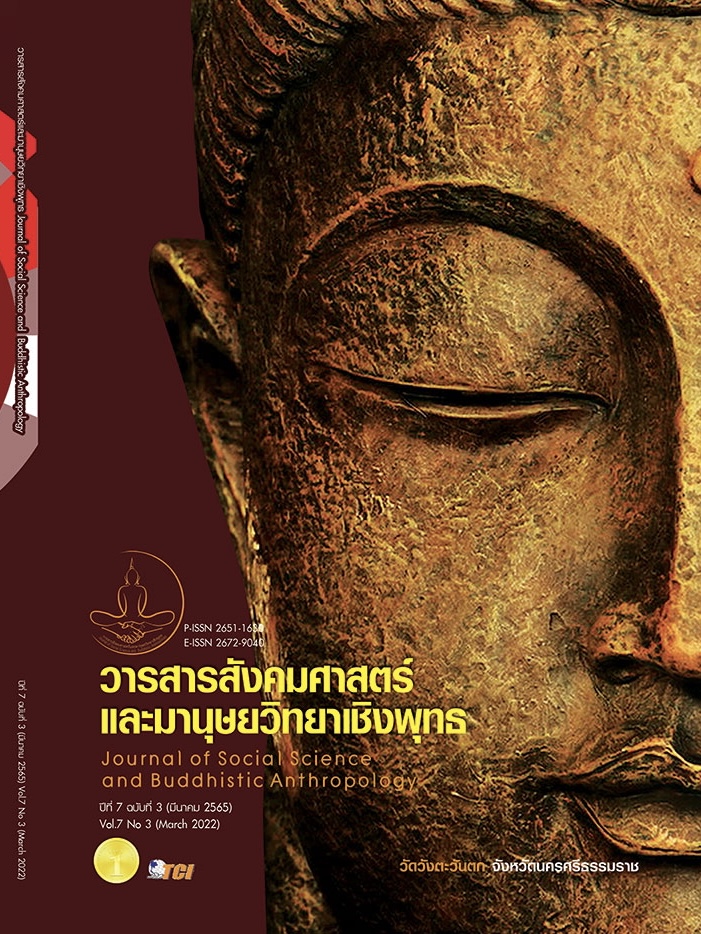THE ADMINISTRATIVE MODEL OF PHAPARIYATIDHAMMA OFFICE FOR PALI EDUCATION IN SANGHA ADMINISTRATIVE REGIONAL 8
Keywords:
Management Model, Phrapariyatidhamma School of Pali Education, Department Sangha Administrative Region 8Abstract
The objectives of this research article were to study administrative conditions, develop and evaluate the administrative model of phapariyatidhamma office for pali education in sangha administrative regional 8 using a mixed research methodology. The research procedure was divided into 3 phases: phase 1 determining the state of phapariyatidhamma office for pali education in sangha administrative regional 8; phase 2 developing the administrative model of phapariyatidhamma office for pali education in sangha administrative regional 8; phase 3 evaluating the model in term of utility and feasibility. The sample group consisted of 274 administrators and teachers who provided quantitative data and 7 experts in the administration of the office of religious studies, who provided qualitative data. Research instruments were two sets of questionnaires. The quantitative data were analyzed by using a computer program, while the qualitative one was analyzed by using a content analysis technique. The research results indicated that: 1) The results of the study of administrative conditions the office of phapariyatidhamma schools of pali education in sangha administrative regional 8 practiced with the major task of pali education as a whole at most level. 2) The developed administrative model of phapariyatidhamma office for pali education in sangha administrative regional 8 consisted of 3 components: Component 1 was a group of major tasks for phapariyatidhamma in pali education which consisted of 8 sub-tasks; Component 2 was a administrative process consisted of 4 steps, and Component 3 was a student knowledge empowerment. 3) The model evaluation results in terms of utility and feasibility. They were both at the most levels.
References
กรมการศาสนา. (2541). รายงานการวิจัย การพัฒนารูปแบบการจัดการศึกษาพระปริยัติธรรมแผนกธรรมบาลี. กรุงเทพมหานคร: โรงพิมพ์การศาสนา.
กระทรวงศึกษาธิการ. (2552). พระราชบัญญัติการศึกษาแห่งชาติ พุทธศักราช 2552. กรุงเทพมหานคร: บริษัทสยามสปอรต์ ซินดิเคท จำกัด.
พระครูสิริสุธรรมวงศ์ (เติมพงฺศ์ มาตย์นอก). (2563). รูปแบบการบริหารงานวิชาการของสำนักเรียนพระปริยัติธรรมแผนกบาลี ในจังหวัดภาคเหนือตอนล่าง. ใน วิทยานิพนธ์พุทธศาสตรมหาบัณฑิต สาขาวิชาพระพุทธศาสนา. มหาวิทยาลัยมหาจุฬาลงกรณราชวิทยาลัย วิทยาเขตนครสวรรค์.
พระมหาสหัส ฐิตสาโร(ดำคุ้ม). (2551). การพัฒนารูปแบบการบริหารมหาวิทยาลัยมหาจุฬาลงกรณีราชวิทยาลัยที่มีประสิทธิผล. ใน ดุษฎีนิพนธ์ปรัชญาดุษฎีบัณฑิต สาขาวิชาบริหารการศึกษา. มหาวิทยาลัยศรีปทุม.
รัตนะ บัวสนธ์. (2550). การบริหารโครงการ: แนวทางสู่ความสำเร็จ. (พิมพ์ครั้งที่ 3). กรุงเทพมหานคร: สำนักพิมพ์จุฬาลงกรณ์มหาวิทยาลัย.
ราชบัณฑิตยสถาน. (2554). พจนานุกรมฉบับราชบัณฑิตยสถาน. กรุงเทพมหานคร: นานมีบุคพับลิเคชั่นส์.
Fetterman, D. M. (1996). Empowerment Evaluation: An Introduction to Theory and Practice. In Fetterman, D.M., Kaftarian, S.J., Wandersman, A. (Eds). Empowerment Evaluation: Knowledge and Tools for Self - assesment and Accountability. Thousand Oaks, CA.
Krejcie, R. V. & Morgan, D. W. (1970). Determining Sample Size of Research Activities. Educational and Psychological Measurement, 30(3), 607–640.
Kusek, J. Z. & Rist, R. C. (2004). Ten Steps to a Results – based Monitoring and Evaluation System:A Handbook for Development Practitioners. Washington, D.C.: The International Bank for Reconstruction and Development/ The World Bank.
Stufflebeam, D. L. & Shinkfield, A. (2007). Evaluation Theory Models and Applications. SanFrancisco, CA: Jossey-Bass.
Downloads
Published
How to Cite
Issue
Section
License
Copyright (c) 2022 Journal of Social Science and Buddhistic Anthropology

This work is licensed under a Creative Commons Attribution-NonCommercial-NoDerivatives 4.0 International License.








